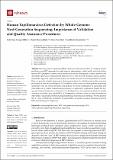Files in this item
Human papillomavirus detection by whole-genome next-generation sequencing : importance of validation and quality assurance procedures
Item metadata
| dc.contributor.author | Arroyo Mühr, Laila Sara | |
| dc.contributor.author | Guerendiain, Daniel | |
| dc.contributor.author | Cuschieri, Kate | |
| dc.contributor.author | Sundström, Karin | |
| dc.date.accessioned | 2021-07-08T16:30:07Z | |
| dc.date.available | 2021-07-08T16:30:07Z | |
| dc.date.issued | 2021-07-08 | |
| dc.identifier | 274974084 | |
| dc.identifier | 721094a2-4c51-412a-9e8f-7daf82a77768 | |
| dc.identifier | 85111107781 | |
| dc.identifier | 000677019800001 | |
| dc.identifier.citation | Arroyo Mühr , L S , Guerendiain , D , Cuschieri , K & Sundström , K 2021 , ' Human papillomavirus detection by whole-genome next-generation sequencing : importance of validation and quality assurance procedures ' , Viruses , vol. 13 , no. 7 , 1323 . https://doi.org/10.3390/v13071323 | en |
| dc.identifier.issn | 1999-4915 | |
| dc.identifier.other | Bibtex: v13071323 | |
| dc.identifier.other | ORCID: /0000-0002-7536-1308/work/96817667 | |
| dc.identifier.uri | https://hdl.handle.net/10023/23498 | |
| dc.description | Funding: This work was funded by the Center for Innovative Medicine (CIMED grant number 613/06, to KS), the Swedish Medical Society (SLS, grant number 885941, to KS),and the Swedish Foundation for Strategic Research (grant number RB13-0011, supporting KS and SAM). The SHPVRL is supported by National Services Division of the National Health Service in Scotland. | en |
| dc.description.abstract | Next-generation sequencing (NGS) yields powerful opportunities for studying human papillomavirus (HPV) genomics for applications in epidemiology, public health, and clinical diagnostics. HPV genotypes, variants, and point mutations can be investigated in clinical materials and described in previously unprecedented detail. However, both the NGS laboratory analysis and bioinformatical approach require numerous steps and checks to ensure robust interpretation of results. Here, we provide a step-by-step review of recommendations for validation and quality assurance procedures of each step in the typical NGS workflow, with a focus on whole-genome sequencing approaches. The use of directed pilots and protocols to ensure optimization of sequencing data yield, followed by curated bioinformatical procedures, is particularly emphasized. Finally, the storage and sharing of data sets are discussed. The development of international standards for quality assurance should be a goal for the HPV NGS community, similar to what has been developed for other areas of sequencing efforts including microbiology and molecular pathology. We thus propose that it is time for NGS to be included in the global efforts on quality assurance and improvement of HPV-based testing and diagnostics. | |
| dc.format.extent | 18 | |
| dc.format.extent | 576398 | |
| dc.language.iso | eng | |
| dc.relation.ispartof | Viruses | en |
| dc.subject | Human papillomavirus | en |
| dc.subject | HPV | en |
| dc.subject | Next-generation sequencing | en |
| dc.subject | NGS | en |
| dc.subject | Whole-genome sequencing | en |
| dc.subject | WGS | en |
| dc.subject | Deep sequencing | en |
| dc.subject | QH426 Genetics | en |
| dc.subject | QR355 Virology | en |
| dc.subject | RA0421 Public health. Hygiene. Preventive Medicine | en |
| dc.subject | T-NDAS | en |
| dc.subject | SDG 3 - Good Health and Well-being | en |
| dc.subject | NIS | en |
| dc.subject.lcc | QH426 | en |
| dc.subject.lcc | QR355 | en |
| dc.subject.lcc | RA0421 | en |
| dc.title | Human papillomavirus detection by whole-genome next-generation sequencing : importance of validation and quality assurance procedures | en |
| dc.type | Journal article | en |
| dc.contributor.institution | University of St Andrews. School of Medicine | en |
| dc.contributor.institution | University of St Andrews. Infection and Global Health Division | en |
| dc.identifier.doi | 10.3390/v13071323 | |
| dc.description.status | Peer reviewed | en |
| dc.identifier.url | https://www.mdpi.com/1999-4915/13/7/1323 | en |
This item appears in the following Collection(s)
Items in the St Andrews Research Repository are protected by copyright, with all rights reserved, unless otherwise indicated.

